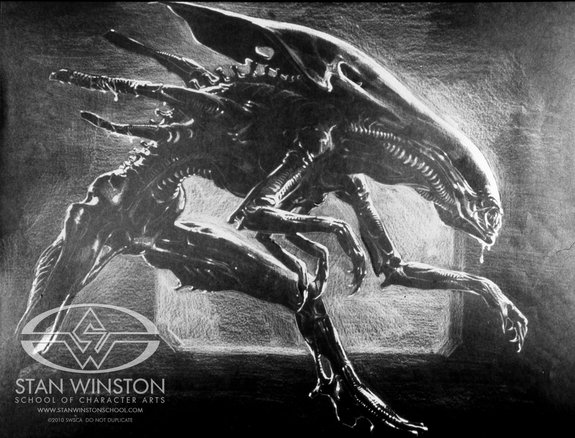The Queen
“Hideous and beautiful at the same time, like a widow spider.” James Cameron. The year was 1984, James Cameron had wrapped up his now very successful movie, “The Terminator”. Following the success of Alien (1979), Brandywine Productions was eager to make a sequel, which took seven years to be completed.
Cameron turned in the finished script in February 1985, and the project was finally green-lit and we could enjoy some amazing design work.
The alien queen was James Cameron’s concept, idea and design, and with very specific instructions was brought to life by the one and only Stan Winston. Their goal was to stay true to the biomechanical aesthetic that had been established by H.R. Giger while still finding ways to push it further. SW and his forty-people-strong crew produced a dozen alien warriors, as well as the full-size Queen, a 14 feet puppet that took sixteen people to operate, including two inside it.






“Even though Giger wasn’t directly involved, his ghost sort of hovered about.” James Cameron.
“Somebody once described it as an anorexic dinosaur, which I supposed is inevitable, even though that’s not what I had in mind,” said James Cameron “In fact, I wanted specifically not to suggest a dinosaur concept because that would have been a little too common place and boring”
At the very beginning of the project, Cameron showed a beautiful rendering of the creature he had done, which Stan W. liked immediately. From there, he and Winston traded sketches before establishing a final design, which then was sculpted at 1/4 scale by a team of SWS (Stan Winston Studio) artists. One of the key artists was Shane Mahan, who tackled the head.
Stan Winston’s School supervisor and co-founder of Legacy Effects, Shane Mahan Sculpting a full size head of the queen.
Stan Winston Studio had not used hydraulics before and considered them as a learning experience. They were essential for moving larger parts of the queen puppet, including the head; a hydraulic foot press in the body moved the tail up and down.
“I thought, ‘This man is out of his mind.’ Nothing like that had been done before. But in the next moment, I realized that if he had imagined it, we could probably do it.” Stan Winston.
Winston and the team built the prototype from black garbage bags, foam and two puppeteers with sticks for claws. Once the team got the prototype to stand and walk, they shipped the design to England to start building the real thing.
After sculpting maquettes, Stan's ALIENS crew moved to England, where they combined forces with Stan's British Alien FX crew and began construction on the queen, replicating one-to-one the 1/4-scale maquette that had been sculpted at SWS.
Once sculpt, mold and cast was done, the creature was painted up and given a variety of supporting rigs, which changed depending on the requirements of the individual shot. The Queen was mainly supported from the bottom with the rig being hidden in it’s vertebrae and sometimes hung with wires of a crane.
In total there were 2 different Queen heads built. One that could withstand the harsh filming conditions and one which was much lighter but also much more fragile for more delicate actions. Articulation was achieved with hydraulics for creating snarls and jaw drops, and a tongue which was controlled independently of the rest.
The Alien Queen was such a complex built and came with so many challenges, it was “as if a bunch of world-class musicians were suddenly handed instruments that they’ve never seen before” (-Stan Winston).
A creation with an enormous learning experience for the entire crew. A pioneer for approaching different methods in SFX and explore new ideas. It also is an important footprint, alongside other astonishing SWS creations, which contributed to the Stan Winston legacy.
Make sure to check out more content over at Stan Winston School.
















